

Claim: Important climate change mystery solved by scientists – Watts Up With That? Revised Holocene temperature record affirms role of greenhouse gases in recent millennia Research News Scientists have resolved a key climate change mystery, showing that the annual global temperature today is the warmest of the past 10,000 years – contrary to recent research, according to a Rutgers-led study in the journal Nature.
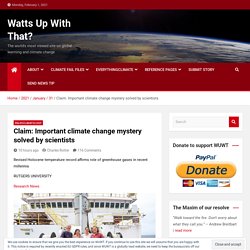
The long-standing mystery is called the “Holocene temperature conundrum,” with some skeptics contending that climate model predictions of future warming must be wrong. Holocene:Glaciers.
CO2 and the Holocene. Holocene: North America. Holocene: Arctic. Holocene: Sahara / Africa. Warmth-Demanding Species, Glacier Melt Measurements Affirm Early Holocene Svalbard Was 7°C Warmer Than Now. By Kenneth Richard on 27.
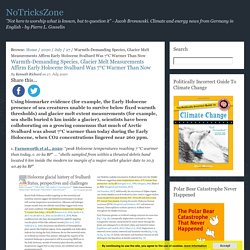
July 2020 Using biomarker evidence (for example, the Early Holocene presence of sea creatures unable to survive below fixed warmth thresholds) and glacier melt extent measurements (for example, sea shells buried 6 km inside a glacier), scientists have been colloborating on a growing consensus that much of Arctic Svalbard was about 7°C warmer than today during the Early Holocene, when CO2 concentrations lingered near 260 ppm. 1. Farnsworth et al., 2020: “peak Holocene temperatures reaching 7 °C warmer than today, c. 10 ka BP” … “shells sampled from within a thrusted debris band located 6 km inside the modern ice margin of a major outlet glacier date to 10.3 ±0.49 ka BP” Image Source: Farnsworth et al., 2020. The Yin and Yang of Holocene Polar Regions. Guest post by Renee Hannon Introduction The Arctic and Antarctic regions are different and yet similar in many ways.
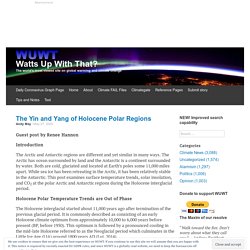
The Arctic has ocean surrounded by land and the Antarctic is a continent surrounded by water. The Holocene Climate Optimum: A Bibliography. The ice of the last ice age began to melt about 20 KYBP (thousand years before the present) but that process was interrupted by the Younger Dryas about 12 KYBP with a return to icy conditions.
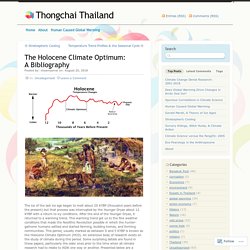
After the end of the Younger Dryas, it returned to a warming trend. This warming trend got us to the fine weather conditions that made the Neolithic Revolution possible in which the hunter-gatherer humans settled and started farming, building homes, and forming communities. This period, usually marked as between 9 and 5 KYBP is known as the Holocene Climate Optimum (HCO). An extensive body of research exists on the study of climate during this period. The Holocene Climate Optimum. By Paul Homewood Booker commented the other day how one scientist claimed last week that we now have “the highest temperatures on Earth since the last ice age”.
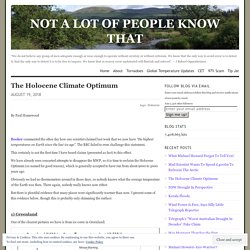
The BBC failed to even challenge this statement. This certainly is not the first time I have heard claims (presented as fact) to this effect. We have already seen concerted attempts to disappear the MWP, so it is time to reclaim the Holocene Optimum (so named for good reason), which is generally accepted to have run from about 9000 to 5000 years ago Obviously we had no thermometers around in those days, so nobody knows what the average temperature of the Earth was then. Insights - What Drives Climate on Earth in the Long Run. Abstract The pattern grid consists of vertical lines for recurring Earth orbital periodicities, and of three more lines, which are horizontally inclined lines, i.e., the Milankovitch line and the upper and the lower orbital oscillation (EOO) boundary line.

The Milankovitch line remained horizontal for six preceding BC millennia, now slowly turning into a descent towards the next glacial. The grid clearly identifies the swivel time span, required for the horizontal Milankovitch line to change into an inclined Milankovitch line with a descent trend of 0.47°C per millennium. The descending secular trend commences right within the first four AD centuries, known as RWP (Roman Warm Period). Heat Waves: Historical, not Hysterical Context. Rannoch Moor, Scotland Alarms are being sounded about heat waves in the Northern Hemisphere, noting heat waves in Eastern Canada and US, wildfires in N.

Sweden and Siberia. Global Temps Plunged 1-2°C Within Decades 8.2 K and 4.2 K Years Ago – And It Could Happen Again. In direct contrast with CO2-centric climate modeling, extensive paleoclimate evidence affirms that the Holocene climate has been far more variable in the past 12,000 years than during the relatively quiescent period we’ve enjoyed since the mid-19th century.
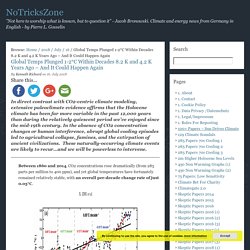
In the absence of CO2 concentration changes or human interference, abrupt global cooling episodes led to agricultural collapse, famines, and the extirpation of ancient civilizations. These naturally-occurring climate events are likely to recur…and we will be powerless to intervene. Between 1860 and 2014, CO2 concentrations rose dramatically (from 285 parts per million to 400 ppm), and yet global temperatures have fortunately remained relatively stable, with an overall per-decade change rate of just 0.05°C. And then they came for The Holocene: New paper suggests “removing the Holocene Epoch from the geologic timescale” Is there any limit to the extremes some climate propagandists will go?
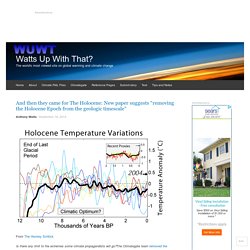
The Climategate team removed the warm 1940’s “blip”, erased the Medieval Warm Period, Hid the Decline, and tortured temperature & sea level data until it confessed, but a paper published Monday in Earth’s Future could take the cake by suggesting removal of “the Holocene Epoch from the geologic timescale” and replacing it with the fictitious, scary-sounding “geologic” timescale “The Anthropocene.” Excerpt from “Hello Anthropocene, Goodbye Holocene”: : “As the official timescale keepers deliberate the introduction of the Anthropocene and a Holocene-Anthropocene boundary (Anthropocene Working Group of the Subcommission on Quaternary Stratigraphy; Zalasiewicz, J., M. et al., 2010; ), they should consider the alternative: Remove the Holocene Epoch from the geologic timescale.
Holocene Thermal Optimum. By Andy May The Holocene Thermal Maximum, also called the Holocene Thermal Optimum, occurred at different times in different parts of the world but generally between 10,000 BP and 4,000 BP.

I use BP to indicate years before 2000. The world ocean was probably 0.7°C warmer than today 8,000 BP. “We Live In The Coldest Period Of The Last 10.000 Years" A Holocene Temperature Reconstruction Part 1: the Antarctic. By Andy May The only recent attempt at a global Holocene temperature reconstruction available today is the one by Marcott, et al. (2013), the paper abstract can be viewed here. His reconstruction is shown in figure 1. Figure 1. A Holocene Temperature Reconstruction Part 2: More reconstructions. By Andy May In the last post (see here) we introduced a new Holocene temperature reconstruction for Antarctica using some of the Marcott, et al. (2013) proxies. In this post, we will present two more reconstructions, one for the Southern Hemisphere mid-latitudes (60°S to 30°S) and another for the tropics (30°S to 30°N). The next post will present the Northern Hemisphere mid-latitudes (30°N to 60°N) and the Arctic (60°N to the North Pole).
As we did for the Antarctic, we will examine each proxy and reject any that have an average time step greater than 130 years or if it does not cover at least part of the Little Ice Age (LIA) and the Holocene Climatic Optimum (HCO). A Holocene Temperature Reconstruction Part 3: The NH and Arctic. By Andy May In the last post (see here) we reexamined the Marcott, et al. (2013) proxies for the Southern Hemisphere mid-latitudes and the tropics. In this post, we will present two more reconstructions using their proxies, these are for the Northern Hemisphere mid-latitudes (30°N to 60°N) and for the Arctic region (60°N to 90°N). These two regions contain over half of the proxies used in this study. The next post will present a global area-weighted composite temperature reconstruction.
As we did in the previous two posts, we will examine each proxy and reject any that have an average time step greater than 130 years or if it does not cover at least part of the Little Ice Age (LIA) and the Holocene Climatic Optimum (HCO). A Holocene Temperature Reconstruction Part 4: The global reconstruction. By Andy May In previous posts (here, here and here), we have shown reconstructions for the Antarctic, Southern Hemisphere mid-latitudes, the tropics, the Northern Hemisphere mid-latitudes, and the Arctic. Here we combine them into a simple global temperature reconstruction. The five regional reconstructions are shown in figure 1. The R code to map the proxy locations, the references and metadata for the proxies, and the global reconstruction spreadsheet can be downloaded here.
Artifacts. New peer reviewed paper says "there appear to have been periods of ice free summers in the central Arctic Ocean" in the early Holocene, about 10-11,000 years ago. Leading German Geologist Calls Notion Of “Climate Tipping Points” Scientific Hype By Opportunistic Scientists. The European Institute for Climate and Energy (EIKE) posted a video of prominent German geologist Dr. Stefan Kröpelin, who in a presentation late last year in Munich called the notion of CO2-induced climate tipping points scientifically outlandish. He also called the prospect of the Sahara spreading into Europe preposterous. EIKE recently wrote an article on the presentation and posted the presentation (in German).
The article follows in English (headings added): ========================================== Stefan Kröpelin geographer and geologist who, after his training at the Free University of Berlin, has been working at the Institute for Prehistory and Early History in Cologne since 1995.